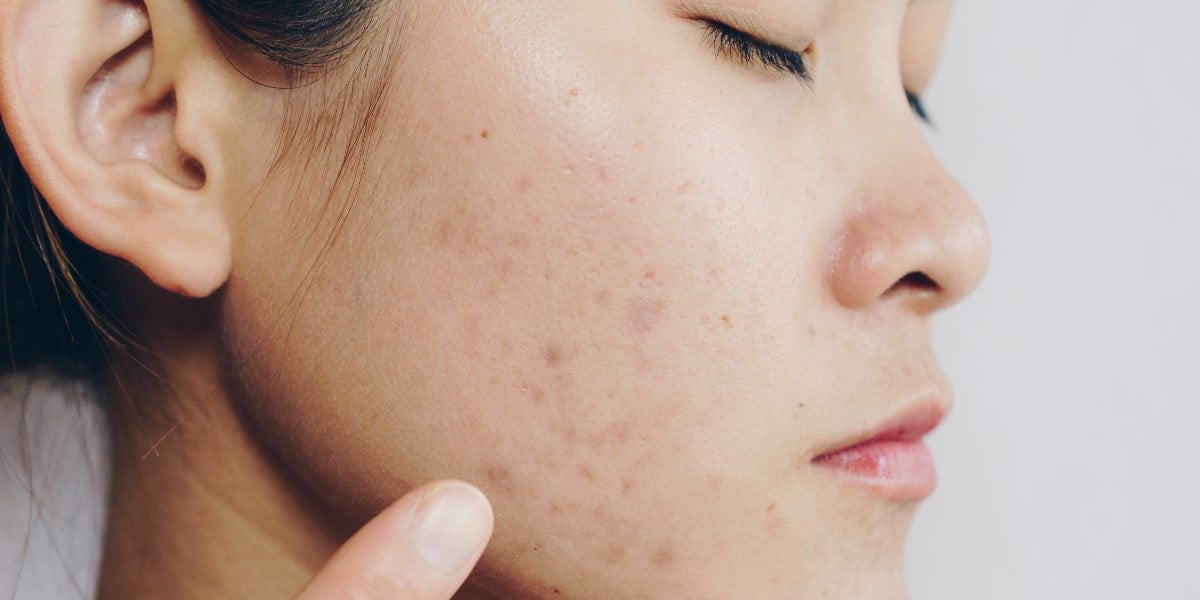Red Light Therapy for Post-Inflammatory Hyperpigmentation
Hyperpigmentation presents as spots that are darker than our regular skin tone. Many of us experience hyperpigmentation following trauma to the skin, such as an abrasion or acne, and hyperpigmentation can be worsened by squeezing, picking, or scratching. While these marks generally fade over time, they can be stubborn and last for years, which can impact our self confidence. Red light therapy can address many skin imperfections, including this troublesome post-inflammatory hyperpigmentation.
What is Post-Inflammatory Hyperpigmentation?
Post-inflammatory hyperpigmentation is a temporary darkening of the skin in an area following inflammation or injury. As inflammation heals, excess melanin is produced, which causes the skin to temporarily darken in that area. If you’ve ever had a dark mark left from a pimple, for example, that mark is post-inflammatory hyperpigmentation. While these dark marks are commonly associated with acne, they can happen from other instances of trauma to the skin, like a cut, scratch, minor burn, or even following an inflammatory skin response like a rash or hives.
Dark marks are temporary and generally resolve themselves, but the process on its own can take three to 24 months, or sometimes longer, depending on the individual. Additionally, if post-inflammatory hyperpigmentation is caused by a chronic issue like acne, hives, or dermatitis, hyperpigmentation will continue to develop until the underlying cause is treated. Repeated trauma to the skin can also worsen dark spots, such as squeezing cystic acne or itching at a rash.
Is Hyperpigmentation a Scar?
Dark marks from post-inflammatory hyperpigmentation are often confused with scars; however, these marks are very different from scars. Scars happen when the dermis, or deeper layer, of the skin has been damaged, causing the collagen matrix in the skin to repair itself irregularly, which is what shows as the lasting mark on the body. Scars are also generally raised (hypertrophic) or depressed (hypotrophic), while post-inflammatory hyperpigmentation marks are flat on the skin. Additionally, many scars appear lighter than the skin tone, but this is not universal.
Post-inflammatory hyperpigmentation does fade on its own, even if it takes some time, while scars are more permanent. In hyperpigmented areas, the dermis of the skin has not actually been damaged, and the excess melanin is part of the healing process. Think of the skin’s response to ultraviolet light (sunlight): melanin is produced to darken the skin and prevent damage from UV rays because the darker tone will absorb less light. In the case of post-inflammatory hyperpigmentation, excess melanin prevents further damage from ultraviolet light.
Learn more about scar tissue and treatments here.
Treatments for Post-Inflammatory Hyperpigmentation
While post-inflammatory hyperpigmentation is part of the skin’s healing process, stubborn dark spots can be annoying or undesirable. However, there are many products that can help brighten dark spots. One common topical treatment for dark marks is an ingredient in many creams and serums called retinol, which increases collagen production and cell turnover. Many people who use retinol products experience redness and peeling skin, a sign of irritation from the product and the reason that some give up on retinol treatments. These products can also be fairly expensive, and they take up to 90 days to begin seeing results.
How Red Light Therapy Improves Hyperpigmentation
Red light therapy is a treatment for a variety of skin concerns, including acne, wrinkles, scars, and sun damage. This therapy uses concentrated wavelengths of red light to stimulate the production of cellular energy, which has a host of responses to speed up natural healing processes. Increased circulation helps supply inflammatory mediators to damaged tissue to resolve inflammation quickly. Additionally, red light therapy increases the production of collagen, which is the major component of the cellular matrix in our skin and helps retain structure and elasticity.
All of our skin is different, so versatility and customization in skin treatments is important. Red light treatments can be customized to each person, using a mix of different wavelengths, wattages (power), and the use of continuous or pulsed light. Additionally, a light bed such as TheraLight’s full body red light therapy systems can treat the entire body at once. This means you can address skin imperfections in more than one area at a time.
Red light therapy is a non-invasive treatment, and it doesn’t cause the irritation and peeling that many experience with retinol products. Additionally, many begin to see results within the first few weeks of treatment.
Learn more about what to expect from your red light therapy session here.
Post-inflammatory hyperpigmentation is something we all experience, but we don’t need to wait two years or longer for the marks to fade. Get started with red light therapy with a TheraLight provider, and find one in your neighborhood through the link below!
This article was originally published on August 31, 2020 and was last updated on July 15, 2024.

